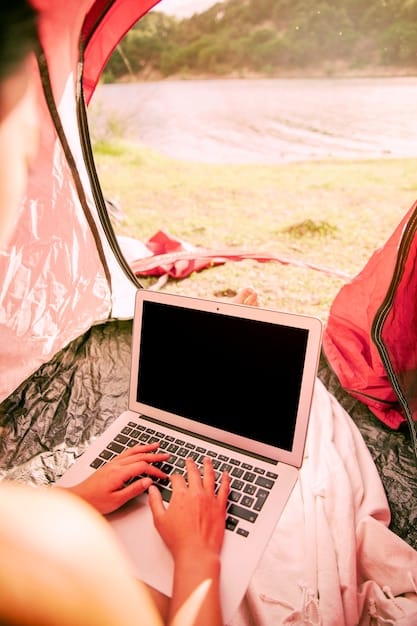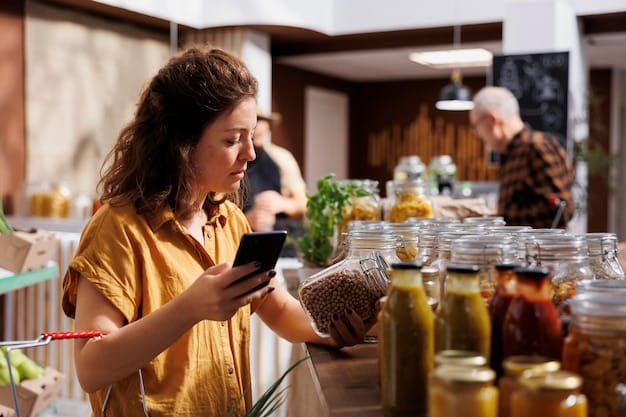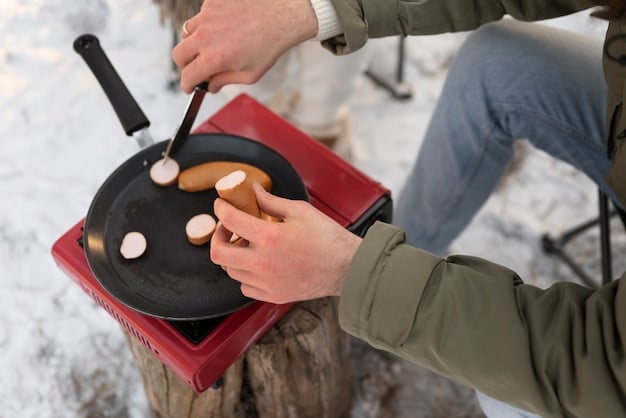Digital Nomad Food: How to Eat Healthy & Cheap in the US (2025)

Eating healthy and affordably while traveling the US as a digital nomad in 2025 requires planning, smart shopping, and creative cooking strategies to balance nutritional needs and budget constraints.
Embarking on a digital nomad journey across the US in 2025 offers incredible freedom, but it also presents unique challenges when it comes to maintaining a healthy and affordable diet. This guide dives into practical strategies to help you navigate the world of digital nomad food: eating healthy and affordably while traveling the US in 2025, ensuring you stay energized and within budget.
Planning Your Digital Nomad Food Strategy
Effective meal planning is the cornerstone of both healthy eating and budget control. By thinking ahead, you can minimize impulsive food purchases and maximize the nutritional value of your meals, no matter where you are.
Pre-Trip Meal Planning and Preparation
Before hitting the road, dedicate some time to mapping out your initial meals. This will prevent you from relying on expensive takeout or unhealthy convenience store options during your first few days.
- Research Grocery Stores: Identify grocery stores along your planned route. Apps like Google Maps can show you locations and even provide insights into pricing and selection.
- Pack Non-Perishable Staples: Stock up on essentials like oats, nuts, seeds, dried beans, and canned goods. These provide a foundation for quick and healthy meals.
- Prepare Some Meals in Advance: If possible, cook and freeze one or two meals that you can easily reheat on the road. Soups, stews, and chili are great options.
Careful planning ensures you start your journey on the right foot, setting the tone for a healthy and affordable food experience throughout your travels.
On-the-Go Meal Adjustments
Even with the best laid plans, adjustments are inevitable. Embrace flexibility and be prepared to adapt your meals as you discover new locations and resources.
- Monitor Your Budget: Keep a close eye on your spending to identify areas where you can cut back. This might involve opting for less expensive ingredients or cooking more meals yourself.
- Explore Local Markets: Farmers’ markets and local produce stands can offer fresh, seasonal ingredients at affordable prices. Plus, you’ll be supporting local businesses.
- Take Advantage of Campground Amenities: Many campgrounds offer cooking facilities like grills and picnic tables, making it easier to prepare elaborate meals.
Remember, the key is to stay adaptable and resourceful. With a little creativity, you can continue to enjoy healthy and affordable meals, even when your plans change.
In conclusion, a well-thought-out food strategy is essential for any digital nomad. Planning your meals, researching grocery options, and staying flexible will contribute to your health, your budget, and your overall enjoyment of the journey.
Smart Grocery Shopping for Nomads
Navigating grocery stores in unfamiliar locations can be daunting, but with a strategic approach, you can optimize your shopping trips for both health and savings.

Prioritizing Nutritious and Affordable Foods
Focus on purchasing whole, unprocessed foods that offer the most nutritional value for your money. These staples will form the base of your meals.
- Buy in Bulk: When possible, purchase items like grains, nuts, and seeds in bulk to save money.
- Choose Seasonal Produce: Fruits and vegetables that are in season are typically more affordable and flavorful.
- Opt for Generic Brands: Generic or store-brand products often offer the same quality as name-brand items at a lower price.
Making these smart choices can significantly reduce your grocery bill while ensuring you’re getting the nutrients you need.
Utilizing Loyalty Programs and Discounts
Many grocery stores offer loyalty programs, digital coupons, and weekly discounts. Taking advantage of these opportunities can lead to significant savings.
- Sign Up for Loyalty Programs: Enroll in loyalty programs at stores you frequent. These programs often provide exclusive discounts and rewards.
- Use Digital Coupons: Check grocery store websites and apps for digital coupons that you can clip and redeem at checkout.
- Look for Weekly Ads: Browse weekly ads to identify discounted items and plan your meals accordingly.
By actively seeking out deals and discounts, you can make your grocery budget stretch even further.
Smart grocery shopping is an essential skill for the budget-conscious digital nomad. By prioritizing nutritious foods, buying in bulk, and utilizing loyalty programs and discounts, you can ensure you’re getting the most bang for your buck.
Mastering Simple Nomad Cooking
Cooking your own meals is almost always cheaper and healthier than eating out. With a few essential tools and techniques, you can prepare delicious and nutritious meals on the road.
Essential Cooking Gear for Digital Nomads
Investing in a few key pieces of cooking equipment can significantly expand your culinary capabilities. Choose items that are compact, durable, and versatile.
- Portable Stove: A single-burner propane stove or induction cooktop is essential for cooking meals in your vehicle or at a campsite.
- Multi-Cooker: A pressure cooker is also perfect for cooking a variety of meals.
- Basic Utensils: Pack essential utensils like a spatula, spoon, knife, cutting board, and mixing bowl.
Easy and Healthy Nomad Recipes
Focus on recipes that require minimal ingredients and cooking time. These options are ideal for busy nomads who want to eat well without spending hours in the kitchen.

Here’s an easy recipe:
- One-Pot Pasta: Combine pasta, vegetables, and broth in a single pot and cook until the pasta is tender.
Remember to adapt recipes to your own tastes and dietary needs. Experiment with different spices, sauces, and vegetables to create your own culinary masterpieces.
Mastering simple cooking techniques is a game-changer for digital nomads. With the right tools and recipes, you can enjoy healthy, homemade meals without breaking the bank.
Snacking Smart on the Road
Snacking can be a healthy way to curb hunger between meals and provide sustained energy throughout the day. However, it’s important to choose snacks wisely to avoid derailing your healthy eating habits and budget.
Healthy and Affordable Snack Options
Opt for snacks that are nutrient-rich, satisfying, and easy to pack. These options will keep you energized and focused on your work.
- Fruits and Vegetables: Fresh fruits and vegetables like apples, bananas, carrots, and celery are excellent sources of vitamins, minerals, and fiber.
- Nuts and Seeds: A handful of nuts or seeds provides healthy fats, protein, and essential nutrients.
- Yogurt: Yogurt is a good source of protein and calcium. Choose plain yogurt and add your own fruit or honey for sweetness.
Avoiding Unhealthy Snack Traps
Be mindful of processed snacks that are high in sugar, salt, and unhealthy fats. These options can lead to energy crashes and weight gain.
- Read Nutrition Labels: Pay attention to the nutrition labels on packaged snacks to identify hidden sugars, unhealthy fats, and excessive sodium.
- Plan Ahead: Pack healthy snacks with you when you leave your accommodation to avoid the temptation of buying unhealthy options on the road.
Choosing healthy and affordable snacks is a simple way to support your overall well-being while traveling. With a little planning, you can avoid unhealthy temptations and stay energized throughout your digital nomad adventures.
Leveraging Technology for Food Management
In the digital age, technology can be a powerful tool for managing your food budget and making healthy choices. Several apps and online resources can help you plan meals, find discounts, and track your spending.
Useful Apps and Websites
Explore available apps and sites that are relevant to your goal:
- Meal Planning Apps: Apps like Mealime and Plan to Eat can help you create meal plans based on your dietary preferences and budget.
- Grocery Shopping Apps: Apps like Ibotta and Checkout 51 offer cashback on grocery purchases.
- Restaurant Discount Apps: Apps like The passport app offer information and/or deals for Restaurants discounts.
Staying Connected for Resources and Support
Join online communities and forums where digital nomads share tips and advice on healthy eating and budgeting.
For example, Facebook groups or online forums are great places to network and share tips for digital nomads. You can find valuable information and support from fellow travelers who are facing similar challenges.
Leveraging technology can streamline your food management efforts, enabling you to make informed decisions, save money, and stay connected with a community of like-minded individuals.
Staying Hydrated on the Road
Staying hydrated is crucial for maintaining energy levels, cognitive function, and overall health, especially when traveling. However, it’s easy to overlook hydration when you’re on the go.
The Importance of Water Intake
Dehydration can lead to fatigue, headaches, and decreased concentration. Make a conscious effort to drink enough water throughout the day.
- Carry a Reusable Water Bottle: Invest in a durable, reusable water bottle that you can refill throughout the day.
- Set Hydration Reminders: Use your phone or a hydration app to set reminders to drink water at regular intervals.
Affordable Hydration Strategies
Avoid expensive bottled water by utilizing free water sources. These strategies will save you money and reduce your environmental impact.
- Refill at Parks and Campgrounds: Many parks and campgrounds have water fountains or spigots where you can refill your water bottle.
- Brew Your Own Beverages: Make your own coffee, tea, or infused water instead of buying expensive bottled drinks.
Prioritizing hydration is a simple yet effective way to support your well-being on the road. By carrying a reusable water bottle and utilizing free water sources, you can stay hydrated without breaking the bank.
| Key Point | Brief Description |
|---|---|
| 🍎 Meal Planning | Strategize meals before trips to avoid costly impulse buys. |
| 🛒 Smart Shopping | Buy in bulk, choose generics, and use loyalty programs. |
| 🍳 Simple Cooking | Focus on easy recipes and essential cooking tools. |
| 💧 Hydration | Carry a reusable bottle and refill at free water sources. |
FAQ
▼
Researching grocery stores along your route and packing non-perishable staples are great ways to plan meals effectively. Also, consider preparing a meal or two in advance that can be easily reheated.
▼
Opt for whole, unprocessed foods like seasonal fruits, vegetables, oats, nuts, and seeds. These are nutrient-rich and often cheaper than pre-packaged or processed alternatives. Buying in bulk can also help.
▼
A portable stove or induction cooktop is crucial. Include a versatile cooking pot, basic utensils like a spatula and knife, and a cutting board. A multi-cooker (pressure cooker) is also perfect for cooking a variety of meals.
▼
Choose snacks like fruits, vegetables, nuts, and yogurt that provide sustained energy. Avoid processed snacks high in sugar or unhealthy fats. Pack your own healthy snacks to avoid unhealthy temptations when you’re on the road.
▼
Carry a reusable water bottle and refill it at parks, campgrounds, or other public water sources. Avoid buying bottled water to save money. Consider brewing your own coffee or tea instead of purchasing expensive drinks.
Conclusion
Balancing healthy eating and budget constraints while traveling the US as a digital nomad in 2025 is achievable through strategic planning, informed shopping, and resourceful cooking. By implementing these tips, you can ensure that your culinary journey is as rewarding and sustainable as your nomadic lifestyle.





